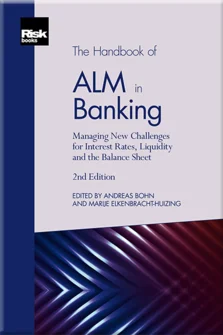Balance-Sheet Management with Regulatory Constraints
Andreas Bohn and Paolo Tonucci
Introduction
Bank Capital and Liquidity
ALM in the Context of Enterprise Risk Management
The New Basel Standards on IRRBB and Their Implications for ALM
Measuring and Managing Interest Rate and Basis Risk
The Modelling of Non-Maturity Deposits
Modelling Non-Maturing Deposits with Stochastic Interest Rates and Credit Spreads
Managing Interest Rate Risk for Non-Maturity Deposits
Replication of Non-Maturing Products in a Low Interest Rate Environment
Managing Mortgage Prepayment Risk on the Balance Sheet
Considerations for ALM in Low and Negative Interest Rate Environments
Credit Spreads
Hedge Accounting
Supervisory Views on Liquidity Regulation, Supervision and Management
Measuring and Managing Liquidity and Funding Risk
Managing Reserve Assets
Instruments for Secured Funding
Asset Encumbrance
Capital Management
A Global Perspective on Stress Testing
Reverse Stress Testing: Linking Risks, Earnings, Capital and Liquidity – A Process-Orientated Framework and Its Application to Asset–Liability Management
XVAs and the Holistic Management of Financial Resources
Optimal Funding Tenors
Funds Transfer Pricing in the New Normal
Balance-Sheet Management with Regulatory Constraints
This chapter will update the reader on the variety of relevant constraints for treasury professionals within banks, and how these constraints have modified the traditional approaches to asset and liability management (ALM). It is no longer sufficient to consider balance sheet management just through a normal business environment; extreme and highly stressed environments should also be considered. The tools needed to achieve this are evolving, and will vary by institution, but here we describe the key considerations for the reader in designing the relevant framework.
With the finalisation of Basel III, three new metrics for balance-sheet risk management will be binding:
- 1.
the liquidity coverage ratio (LCR) defines a minimum for the liquidity buffer relative to potential outflows in a stress scenario;
- 2.
the net stable funding ratio (NSFR) defines a minimum for stable sources of funding to the term funding requirements on the asset side;
- 3.
the leverage ratio sets a minimum for capital as a percentage of total balance-sheet size.
These ratios will supplement the already implemented and updated Basel II solvency ratio, which sets a minimum level of
Copyright Infopro Digital Limited. All rights reserved.
As outlined in our terms and conditions, https://www.infopro-digital.com/terms-and-conditions/subscriptions/ (point 2.4), printing is limited to a single copy.
If you would like to purchase additional rights please email info@risk.net
Copyright Infopro Digital Limited. All rights reserved.
You may share this content using our article tools. As outlined in our terms and conditions, https://www.infopro-digital.com/terms-and-conditions/subscriptions/ (clause 2.4), an Authorised User may only make one copy of the materials for their own personal use. You must also comply with the restrictions in clause 2.5.
If you would like to purchase additional rights please email info@risk.net











